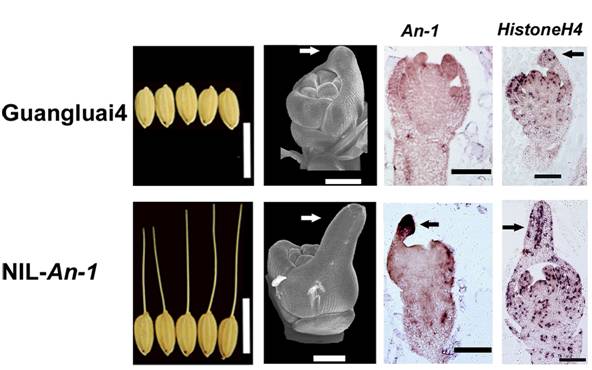An-1, a New Domesticated Gene to Regulate Awn Formation
As an important agricultural crop, the Asian cultivated rice Oryza sativa is considered to be domesticated from the ancestor of the wild rice species Oryza rufipogon about 8000 years ago. Domestication involves a series of profound genetic changes resulting from human selection, which makes a wild species modify traits to ultimately benefit humans. Identification and functional investigation of domesticated genes will provide molecular evidences to elucidate mechanism of domestication.
Recently, a group led by Dr. Bin Han from the Institute of Plant Physiology and Ecology, Shanghai Institutes for Biological Sciences reported the molecular cloning of a major quantitative trait locus, An-1, which is a domesticated gene and regulates long awn formation in O. rufipogon.
Long awns are important for seed dispersal in wild rice, but are absent in cultivated rice because long awns are not favorable during harvest and storage. The genetic mechanism involved in loss-of-awn in cultivated rice remains unknown. Researchers from Dr. Han’s group cloned the major QTL An-1 that encodes a basic helix-loop-helix protein and regulates the long-awn trait in wild rice. An-1 is intensely expressed at the apex of the lemma primordia, specifically causing continuous cell division to form a long awn. Upregulation of An-1 expression could induce long awns as well as reduce grain number per panicle in awnless cultivated rice, whereas RNA interference of An-1 in a long-awn indica variety Kasalath generated shorter awns but produced more grains per panicle compared with the control plants.
They found that genetic variations in the An-1 locus were associated with awn loss in cultivated rice. Population genetic analysis of wild and cultivated rice showed a significant reduction in nucleotide diversity of the An-1 locus in rice cultivars, suggesting that the An-1 locus was a major target for artificial selection. Therefore, awn loss was favored and strongly selected by humans, as genetic variations at the An-1 locus that cause awn loss would increase grain numbers and subsequently improve grain yield in cultivated rice.
This work entitled “An-1 Encodes a Basic Helix-Loop-Helix Protein That Regulates Awn Development, Grain Size, and Grain Number in Rice” has been published online in the Plant Cell on September 28, 2013.
The research was funded by the grants from the Ministry of Science and Technology of China, the Ministry of Agriculture of China, and the National Natural Science Foundation of China.
Comparison of awn length, awn development and gene expression patterns between Guangluai4 and NIL-An-1 (Image by Dr. Bin Han’s Group)
CONTACT:
Bin Han
National Center for Gene Research
Institute of Plant Physiology and Ecology, Shanghai Institutes for Biological Sciences, Chinese Academy of Sciences.
Tel: 86-21-54971325; Email: bhan@ncgr.ac.cn
